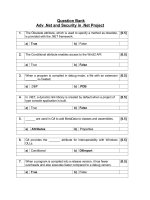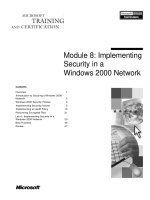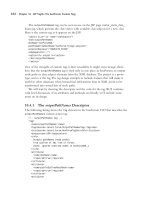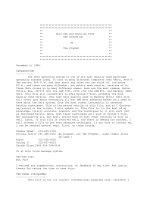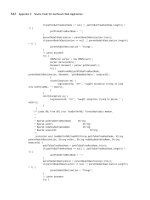Security in SNMPv3 versus SNMPv1 or v2c pdf
Bạn đang xem bản rút gọn của tài liệu. Xem và tải ngay bản đầy đủ của tài liệu tại đây (146.17 KB, 6 trang )
1
Security in SNMPv3 versus SNMPv1 or v2c
Introduction
Simple Network Management Protocol (SNMP) is an interoperable standards-based
protocol that allows for external monitoring of the Content Engine through an SNMP agent.
An SNMP-managed network consists of three primary components: managed devices,
agents, and management systems. A managed device is a network node that contains an
SNMP agent and resides on a managed network. Managed devices collect and store
management information and use SNMP to make this information available to
management systems that use SNMP. Managed devices include routers, access servers,
switches, bridges, hubs, computer hosts, and printers.
An agent is a software module that has local knowledge of management information and
translates that information into a form compatible with SNMP: the Management
Information Base (MIB). The agent can send traps, or notification of certain events, to the
manager.
A manager is a software module that listens to the SNMP notifications sent by SNMP
agents. The manager can also send requests to an agent to collect remote information
from the Management Information Base (MIB).
The communication between the agent and the manager uses the SNMP protocol, which
is an application of the ASN.1 BER (Abstract Syntax Notation 1 with Basic Encoding
Rules), typically over UDP (for IP networks).
Version 1 (SNMPv1, described in RFC 1157) is the initial implementation of SNMP.
Version 2 (SNMPv2c, described in RFC 1902) is the second release of SNMP. It provides
additions to data types, counter size, and protocol operations.
Version 3 (SNMPv3, described in RFC 2271 through RFC 2275) is the most recent
version of SNMP. It became a full IETF standard, making SNMPv1 and v2c historical.
Threats of Network Security and their Relation to Network Management
SNMP version 1, or SNMPv1, has enjoyed unparalleled success as an interoperable
management solution. However, it had multiple shortcomings, the most notable of which
was its lack of strong security
This section describes the different kind of threats. Within the explanation of each threat
it's also explained what kind of effects the threats have on the network management in
general. That is, how the threats show up in the security of the network management.
3 Masquerading means that an attacker succeeds to act in someone else's role and
perform some tasks on behalf of the victim. In the security of network management
at the moment, this is perhaps the most critical threat. One way to masquerade is to
use spoofing. If a malicious attacker succeeds to act as an authorized manager,
the doors are open for him to manage the network with the rights of the authorized
Ubizen AETHIS
Member of the Ubizen group
2
manager: The attacker can do anything that is permitted to the manager that is the
victim.
3 Modification of Information. The threat of the modification of information means
that some third party can intercept the transmission of the message and maliciously
modify the in-transit message. Then the modified message is passed to the original
receiver. Now the receiver of the message thinks that the message was sent by the
trusted source while the contents of the message are changed. In network
management, an authorized network manager can generate a valid management
PDU. If an attacker succeeds to intercept the transmission, the whole PDU can be
changed while keeping the authentication information unchanged. Of course, this is
possible only if the PDU is not signed, nor encrypted.
3 Message Stream Modification means that the stream of messages is modified
somehow. This means that the messages could be reordered, or the messages
could be recorded and replayed. The network management design originally aimed
to connectionless management protocols. And since the most of the management
protocols were designed to operate on connectionless transport services the
message stream modification is a severe threat in network management. An
attacker could for example record the valid management message that orders the
router to shut down. Then, in the future, the attacker could use the captured
message to perform the router shutdown whenever he wanted to do so.
3 Disclosure. The threat of disclosure means that confidential information is leaked
to the people who shouldn't see it. In network security in general, sniffing the traffic
that is not encrypted is one way to do it. Also, in network management, some
managment PDUs can carry some crucial information about the network and
managed nodes itself. So, if an attacker spies the management traffic in a network
segment, he could get some important information. That information could be used
as the basis for other attacks, such as masquerading. A way to fight the threat of
disclosure is to encrypt the messages.
3 Denial of Service (DoS) means that some network service will become blocked
somehow. Attacker could for example try to open TCP connections to a host
continuously and that way block all the other connection requests. In network
management this could mean that an attacker succeeds in blocking the flow of
management protocol messages between the manager and the agent. In the
network management, the DoS can also be a consequence if the other threats take
place. For example, if an attacker succeeds to masquerade and act as the network
manager, he can possibly give the shutdown command to a specific router. And this
is, in fact, a denial-of-service type of threat taking place.
3 Traffic pattern analysis is a threat where the information contents of the
messages are ignored. Instead, the crucial information of the system is extracted
from the usual patterns of the traffic flow. Both of these last two threats are hard to
prevent.
3
(In-)security of SNMPv1
The basic SNMP has very primitive security functions. The only mechanism to
authenticate a manager is by so called community name. The community name is used in
defining management groups with differing access rights. That is, the community name is
used to define which managers are allowed to submit get or set requests. The same
community name mapping is used to define access policies for different managers. That
is, some names may be restricted to operate only on some the areas of MIB while the
others may have greater rights.
The SNMP community is locally defined at a node and the same name may be used at
multiple nodes. When a manager wants to perform some kind of management task (get or
set) it always has to present the community name that matches its need for access rights.
In order to manage a selection of nodes the manager has to maintain a list of all the
relevant community names.
As one might think, this can't be considered a secure way to authenticate the user.
Anybody who knows a community name with powerful rights can act as a manager for a
possibly large selection of nodes. And, in addition, compromising a community name
compromises the security of the management in the network. The second problem with the
security of the SNMP is the fact that there is no privacy. That is, there is no possiblity to
encrypt the management message. When all the traffic flows through unsecured public
network, nobody can tell if someone is spying the traffic. This leaves a second huge hole
in the security of SNMP: anybody could listen to unencrypted UDP based SNMP traffic
and catch the community name at a router, for example. This means that eavesdropping
and masquerading are the most obvious threats to take place.
The weak authentication of the SNMP is bad enough by itself. Combining this with the lack
of privacy make things even worse. The ease to sniff plain-text UDP traffic makes the
weak authentication of the SNMP even weaker. And, that in turn makes the threat of
sniffing even greater threat it normally would be. So, in sense, the two basic problems with
the SNMP worse each other.
Due to the total insecurity of the SNMP, it is mostly used only for monitoring the agents.
Actually, in most implementations, the SNMP "set" function is disabled just because it is
ridiculously easy for an attacker to maliciously manage someone else's devices.
(In-)security of SNMP version 2
The SNMPv2 standardization wasn't successful. The standardization process resulted in
three mutually incompatible standards (SNMPv2 party-based, SNMPv2u and SNMPv2*).
Originally, the specification and designing of the SNMPv2 was initiated to enhance SNMP
functionalities and the security was given some priority. A security scheme called "Party-
Based Security" was introduced. Because the original SNMPv2 proposal was never really
taken into any broader use, the Party-Based Security Model isn't introduced here. The
standardization process of SNMPv2 was stuck with two competing proposals: SNMPv2u,
SNMPv2* which both had a user-based security model. Unfortunately, a compromise was
made and a proposal named SNMPv2c was standardized.
Why the SNMPv2 has a weak security? The answer is easy: The fruit of the
standardization, the SNMPv2c, has no change to basic SNMP in terms of security - it
relies completely on the familiar community strings.
4
Security of SNMPv3: a new message processing module
Using SNMPv3, users can securely collect management information from their SNMP
agents without fear that the data has been tampered with. Also, confidential information,
such as SNMP set packets that change a device's configuration, can be encrypted to
prevent their contents from being exposed on the wire. Also, the group-based
administrative model allows different users to access the same SNMP agent with varying
access privileges.
Basically, the effective PDU, that is either SNMPv1-PDU or SNMPv2-PDU, is
encapsulated in an SNMPv3 packet. This encapsulation provides security related functions
on the level of message processing.
In SNMPv3, each entity – manager and agent – contains a single SNMPv3 engine to
perform the message processing. When an application wants to send SNMP PDUs to the
node in the network the following happens: The engine first accepts the SNMP datagram
to be sent from SNMP application level, performs the appropriate security functions,
encapsulates the PDU into an SNMPv3 message and then transmits the message to the
network. When the engine receives an SNMPv3 message from the network, it performs
the necessary decryption and authentication functions before passing the PDU to the
SNMP applications.
User-Based Security Model (USM)
USM is the security model that implements the actual security services for authentication
and privacy. Two different secret keys are needed, one for privacy (encryption key or
privacy key, privKey) and the other for authentication (authentication key, authKey). These
keys are not stored in the MIB of the node. Therefore they are not directly accessible
through SNMP get- or set-functions.
Authentication and Integrity
For authentication of sender and checking the integrity of messages the USM supports two
different authentication protocols, both of which are based on a widely used HMAC.
HMAC-MD5-96 is a protocol where the secure hash function is MD5. The HMAC-SHA-96,
on the other hand, uses SHA-1 for hashing. Inputs for both of the hash functions are the
message to be sent and secret authentiction key of the user (authKey). Both hash
functions produce an output, which is in both cases truncated to a message authentication
code (MAC) of 12 octets. The calculated and truncated MAC is then appended to the
message to be sent.
Upon reception the recipient does the following. The received message and the authKey
are used as inputs for HMAC to calculate the MAC as was done when the message was
sent. Now, if the calculated MAC is not the same as carried with the received message,
the message is ignored. If, on the other hand, the MAC that was just calculated is the
same MAC the received messages contained, the recipient can be sure about two things:
1. Integrity: The message couldn't be changed during the transmission. An attacker
would have to know the secret authKey to change the message without being
noticed.
2. Authenticity: To calculate the correct MAC the sender has to know the secret key.
And, if the secret key is only known by the sender and the recipient, one can be
sure that the message was sent by the authentic party.
5
Timeliness Verification of Messages
The security function of authentication doesn't prevent message delay or message replay
attacks since actually there is nothing unusual in replayed messages. To make the
SNMPv3 secure against this kind of flow manipulating attacks the USM has a timeliness
mechanism. Actually, SNMPv3 demands that the messages must be received within
reasonable time window.
The timeliness mechanism is based on two counters associated with each single SNMP
engine: the snmpEngineBoots and snmpEngineTime. When an SNMP engine is installed,
both of the two values are set to zero. After the SNMP engine has been started,
snmpEngineTime is incremented once per second. Using a complex synchronization
mechanism, an SNMP engine maintains an estimate of the values of time for each of the
remote engines with which it communicates. These estimated values are placed in each
outgoing message. The receiving management node's SNMP-engine then determines
whether or not the incoming message is in the acceptable time window of 150 seconds. If
the message doesn't fit the time window, it is simply ignored.
Privacy Through Encryption
For privacy, the USM uses Data Encryption Standard for ciphering messages. More
precisely the CBC-mode of DES is used. The secret key needed for encryption is gained
by taking the first eigth octets of the privacy key (privKey) assosiated with the user. The
initial vector (IV) needed for the DES encryption algorithm is same as the last eight octets
of privacy key. The encryption of the messages is optional. Like authentication key, the
encryption key has to be set locally at the managed node.
Using secret key (symmetric) cryptography presents the SNMPv3 system additional
challenges. The management of keys becomes a usability and security issue. If all the
managed nodes have different secret keys the manager has to possess the same number
of secret keys that there are managed nodes. The setup and management of keys quickly
becomes a burden. If the management station is hacked and the secret keys
compromised, all the nodes have to be reconfigured by hand. On the other hand one might
like to use just one and the same secret key at all the managed nodes. The problem with
this is that the compromising the only secret key compromises the security of the entire
management system – that is, all the managed nodes. In USM, however, this problem is
solved by utilizing a technique called Key Localization. The key creation, update and
management are described in RFC-2274. The idea is to generate a unique key (called
localized key) for each user-SNMP-engine pair by using user's password and
snmpEngineID, which is the id of the target SNMP engine.
View-Based Access Control
In general, there exist various ways to manage the access control, that is, determing the
access rights of a remote user to alter or view the local MIB. This means that the access
control is a security function that is performed at the PDU level. The access control
mechanism intended to be used with SNMPv3 is called View-Based Access Control
(VACM), specified in RFC-2575.
The VACM is specified to determine the access rigths per group basis. This is different
from the USM which specifies the authentication of users individially. In VACM each user
has to be included in some group and the different groups can then be granted different
security levels. This means that there might be, for example, a group of root managers,
which have the ultimate control to alter all the parameters in all the managed nodes.
6
Additionally, there could be a group of minor, observing managers who would be granted
only read permissions to certain parts of each local MIB.
The access rights are stored in different tables at the node and each of the tables is
consulted to determine the access rights of the requesting manager. The procedure is
based on the following concepts:
• "Who" is the subject of the operation and is defined by securityModel and
securityName. This subject then belongs to one group at this SNMPv3 node.
• The contextName specifies "where" the desired management object can be found.
• "How" is the combination of securityModel and securityLevel and it defines how the
incoming request was protected.
• The viewType specifies the type of access request ("why"). The options are read,
write, or notify access request.
• The object of the SNMP operation ("what") is defined by the variableName.
The final access decision is made by comparing the variableName to the retrieved MIB
view. If the variableName is found in the MIB view the access is granted.
Credits
Configuring Network Management: Copyright © 1992 2002 Cisco Systems, Inc.
The Security of Network Management: Toni Paila, Department of Computer Science, Helsinki University of Technology, 1999.
Copyright © 200
2
SNMP Research International, In
c.
SNMP Research Contact information
(European Competence Center)
Ubizen AETHIS
Rue du Bosquet, 7 - B-1348 Louvain-la-Neuve - Belgium
Tel.: + 32 10 456 130 - Fax: + 32 10 456 155
Email: - Website:
